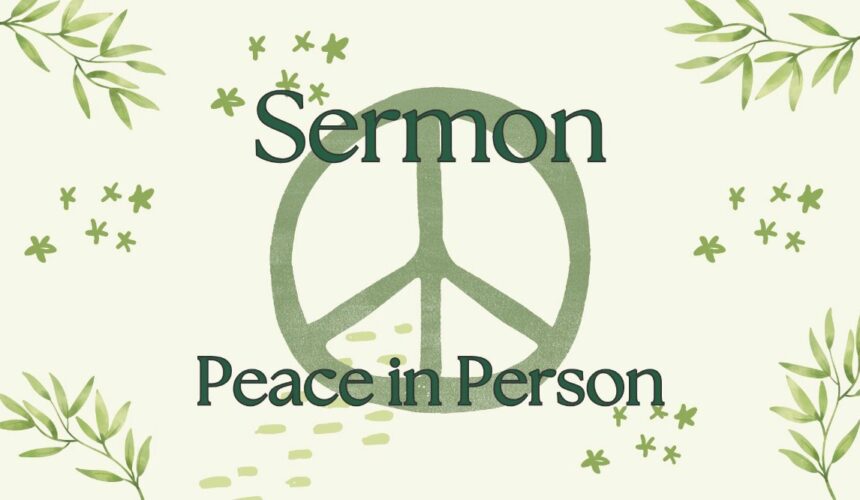Peace in Person
University Park United Methodist Church
18th Sunday in Ordinary Time
September 22, 2024
Scripture: Ephesians 2:14 – 22
This week, I learned that the oldest structure on earth built by human beings, or at least the oldest one that’s been discovered so far, is a fish trap. There’s debate about just how old it actually is, but a lot of the people who study this stuff agree that sometime between 30 thousand and 40 thousand years ago, a group of people living in what we know as the Australian state of New South Wales gathered rocks of various sizes and built a whole bunch of channels and circular pools in the Barwon river. So fish would swim down the river and enter one of these channels They would swim along between the rock walls until they got to a circular pool. And when they did, the people watching would take some rocks and quickly block the exit to the pool so the fish couldn’t go anywhere. When the people were ready to eat some fish, they would come back and pull them out of the pool. One video I watched about this said that it was kind of like having a giant fridge that always restocked itself – and had an amazingly great energy star rating.
It turns out, though, that the fish trap is probably an exception when it comes to the oldest structures on earth. Other ancient human structures tend to be burial sites, temples, or monuments to the power of the King who ordered them built. Sometimes, they’re all three at once, like the pyramids in Egypt. Since many of the world’s oldest structures were built before written records, it’s hard to tell exactly why they were built. But historians and archaeologists can make some pretty good guesses. Often, a large gravesite has a special section in it where people were buried with luxurious goods and ornate weapons. It’s not hard to imagine that these were rulers or military heroes, separated from the common people. Sometimes people who may have been servants or slaves were buried with them.
All of these ancient structures, whether they were monuments, burial mounds, temples, whatever – all of them seem to have ways of separating people, dividing them by levels of honor or worth or power (except maybe fish traps). Ancient temples often have some inner space, separate from the rest of the structure, where only certain people could go. Public buildings and statues were often created as monuments to the ruler who had power and the money to get them built. It seems like one important function of ancient structures was to divide people by levels of value or wealth or power.
I guess that means in certain ways we haven’t changed a whole lot. Burial customs are changing, but it’s still true that some practices are a lot more expensive and exclusive than others. If we’re talking about public monuments, our country has been in a raging argument for years now about what public monuments mean: who should get a statue, who should have a building or a mountain named after them, who should not, and why? Who should have the power to make those decisions, and why?
And even today, maybe especially today, our sacred spaces can separate us. Where we go to church, or if we go to church, is treated like a litmus test of our political and social views. People often experience churches as places of painful rejection and condemnation, places that put up barriers to God and barriers to authentic community. Instead, churches should be places where everyone is invited to connect with a God of grace and share life with others. But they’re often not. After all these years, our religious spaces and our monuments can still divide us.
No one’s really sure who wrote the letter to the church at Ephesus that we heard Sarah read from this morning. Some scholars think it was the Apostle Paul. Most think it was a follower of his who studied his ideas deeply. But whoever wrote Ephesians would have been very familiar with the way monuments and temples can divide people. Ephesus was like other cities throughout the Mediterranean world. There were temples there to Roman Gods, and even though Ephesus didn’t have a temple where people could worship the Emperor, nearby cities did. Statues of the Emperor or of past Emperors were often put up in the middle of Roman cities, to remind everyone of the power and greatness of their ruler. Even Roman money was stamped with artistic representations of the Empire’s military conquests, or phrases like, “The Deity Augustus, our Father.” All of this was part of an ongoing propaganda campaign to remind Roman citizens that they were part of a great power, and to remind conquered subjects that they were not and it was useless to resist.
In the Jerusalem temple, the holiest place in all of Judaism, foreigners were welcome. They were sometimes even called “righteous gentiles,” people who found wisdom and beauty in Jewish scripture and worship although they were not Jews. But even the temple had a wall beyond which no one who was not Jewish could pass, a space where only Jews could gather. Even in our God’s temple, the practice of separation between peoples was enforced.
So in that world, where people were divided by custom and bigotry and institutions and even architecture, this new religious movement of early Christianity faced a problem: how to unite Jews and Gentiles? But Jew and Gentile were just the start of the Christian movement’s diversity. The early church contained citizens and noncitizens, rich and poor, Aramaic speakers and Greek speakers, men and women, slave and free. Those first Christians faced a near-impossible challenge: how to be one group, all dedicated to the same ideals and goals? How to be a group that transcended all the traditional separations and hostilities?
This would not have been an easy or trivial question in the first century, any more than crossing the chasms that separate us today is easy or trivial. In the first century, most Jews would have thought of themselves as a people set apart for God. Some were Roman citizens. The Apostle Paul was, and there were others. But Jews spoke their own language and followed their own religious law and did not keep Roman customs, which meant they were constantly suspect and accused of being faithless and unpatriotic.
Romans for their part had all kinds of reasons to believe in their superiority: an ancient philosophical and political tradition; the most technologically and militarily advanced society in the known world; the most powerful and vast Empire in history. Both groups believed strongly in their own culture and their own way of life, and they had the monuments and the temples and the laws and the customs to hold themselves apart and above.
I think the author of Ephesians thought a lot about these issues, and came up with a beautiful answer. In the second chapter, Ephesians says, “(Christ) is our peace. He has made both groups into one and broken down the dividing wall…In him the whole structure is joined together and grows into a holy temple…you also are built together…into a dwelling-place for God.”
Whoever wrote this is telling the Ephesian Christians that as they become followers of Christ, all the walls, whether those walls are spiritual or physical; all the walls of the temples and monuments and traditions and institutions that kept them apart – have all been torn down. Together, these Christians are not just creating a new structure. Together, they are the new structure: a new structure composed of parts that would never seem to fit together, but that somehow do anyway. And that building, that new structure, doesn’t have walls to keep people out. It doesn’t have a special place where only certain people are allowed. It doesn’t have some people who are worth more than others. And to the degree that they can allow that kind of community, they will be built together into a dwelling place for God.
I think that like the Ephesian Christians, we have a choice to make now, in our culture. We can keep on putting up monuments and tearing monuments down and continue our vicious argument about what we should value. We can build our churches around nationalism and ideological purity and keeping the wrong people out. We can create a forced peace that is really just the temporary absence of hostility and combat. And that peace will hold until it doesn’t, and people start shooting at each other. Or in our case, I guess we should say that people keep shooting at each other, keep making death threats, keep spreading hatred and fear and division and rage.
Or we can allow ourselves to be the example that shows something different is possible. We can allow ourselves to be built into a structure that does not divide, does not glorify power and elevate some at the expense of others; but becomes a dwelling place for God, one made of our commitment to all creation’s flourishing. Ephesians tells us the true monument to God is not a temple or castle or a church or a magnificent statue. The true monument to God is us. It’s the community we form, where we value others as God values us, in all our powerful unity and all our beautiful and sometimes maddening diversity.
If you were following events in Egypt twelve or thirteen years ago, you might remember the revolution there that eventually overthrew their President. Things started out with relatively peaceful protests, but soon began to turn violent. Coptic Christians were attacked. Some churches were bombed. Muslims were also being attacked. Mosques were bombed. And then one day in Tahrir Square, in the middle of Cairo, a group of Muslims at a protest knelt for their midday prayer. And a circle of Christians formed around them, holding hands, facing outward, creating a human shield to protect their Muslim neighbors. Not long after, on a Sunday morning, Muslims surrounded a local church, again facing outward, holding hands, a human shield against anyone who would attack their Christian neighbors. And for a time, this little miracle became a common practice. It happened in 2011, and again through 2013, and again in 2019. Muslims and Christians, whose outlook on some matters could not have been more different, protected each other. During some of the worst tensions their country had experienced, where vengeance and violence were everywhere, where people were being shot and beaten and women (including, as you may remember, the journalist Lara Logan) were being viciously assaulted on the streets, even in those conditions some groups of faithful people chose another way.
Now we could say that’s a long way from the Christian unity Ephesians is promoting. And in a sense that’s true. But I think it’s also true people were looking out for each other in these violent and confusing conditions, where it was sometimes impossible to tell the heroes from the villains. Those people who chose the way of compassion and self-giving, who put themselves at risk to nonviolently defend others, were showing the world that even in the worst conditions another way is possible. They allowed themselves to be built into a dwelling place for God. And if that’s possible in Egypt in 2011 and 2013 and 2019, it’s possible here in 2024. I think we’re called to find out.


